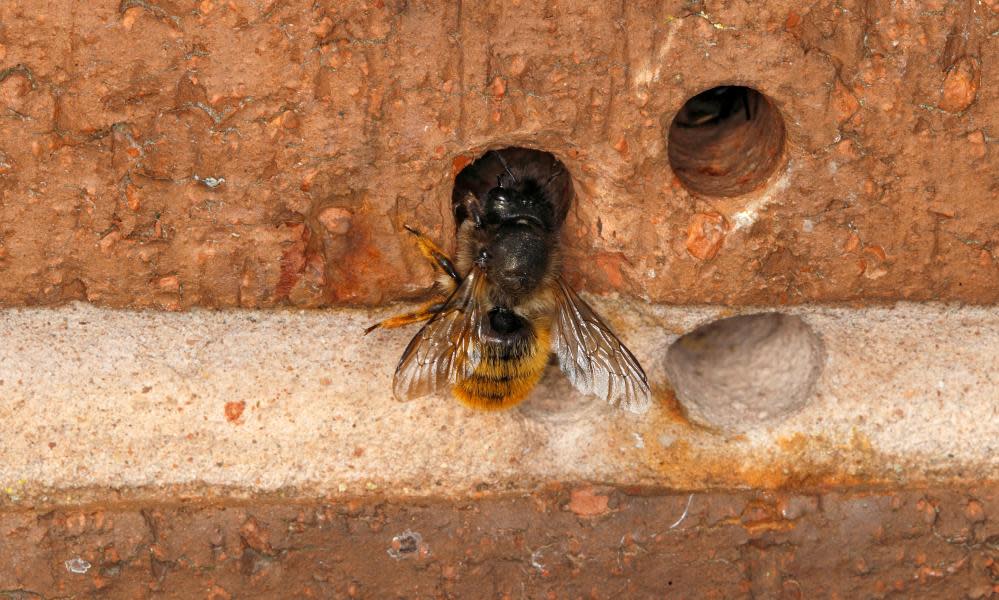Brighton bee bricks initiative may do more harm than good, say scientists

An initiative in Brighton aimed at helping protect the bee population could do more harm than good, scientists have warned.
The council in Brighton has passed a planning condition that means any new building more than five metres high will have to include swift boxes and special bricks with holes known as bee bricks. They will provide nesting and hibernating space for solitary bees.
However, scientists have warned that such a move will not make any real difference for biodiversity, with some arguing that it could make matters worse for bees if the holes are not cleaned properly and attract mites or encourage the spread of disease.
The idea was first raised in 2019 by councillor Robert Nemeth, and the condition was attached to all planning permissions after 1 April 2020.
Dave Goulson, a professor of biology at the University of Sussex, said he had tried a bee brick out and that the holes were not deep enough to be “ideal homes for bees” but “are probably better than nothing”.
He added: “Bee bricks seem like a displacement activity to me. We are kidding ourselves if we think having one of these in every house is going to make any real difference for biodiversity. Far more substantial action is needed, and these bricks could easily be used as ‘greenwash’ by developers.”
Sebastian Worms, a graduate student from the University of Louvain in Belgium, said that the bricks were more educational tools for children and could have a negative impact if they were too big and not cleaned enough. “To help bees it would be better to introduce more flowers,” he said.
Adam Hart, an entomologist and professor of science communication at the university of Gloucestershire, said that sometimes “well-meaning interventions can have unwanted consequences”.
“It would be good to have much more research on all of these ‘bee hotels’ so bees can get the maximum benefit from people’s desire to help them,” he said.
Not everyone was in agreement that the bricks were a bad idea. Francis Gilbert, a professor of ecology at the University of Nottingham, said that bee bricks did not need to be cleaned. “The mites will leave after one to two seasons and then the bees will recolonise,” he said.
“There will be beneficial microbes in the holes as well, so they should not be cleaned. So bee bricks are an unequivocal good thing.”
Lars Chittka, a professor in sensory and behavioural ecology at Queen Mary University, said that bees “naturally possess hygienic behaviour that would allow them to mitigate the risks at least to some extent, or that they would assess the holes’ states before using them, which should to some extent counterbalance the risks that come with such long-term nesting opportunities.”
He added: “It might well be that the Brighton project provides an opportunity to study the risks and benefits on a reasonably wide scale, and over an extended period – say five years. But I would certainly recommend not copying this project across the country before the long-term benefits and risks are explored.”
Nemeth, who is also a beekeeper, said: “There’s a well-known saying in the beekeeping world that if you ask 100 different beekeepers a question then you get 101 different answers.
“It’s going to take some years yet to establish the degree of effectiveness of bee bricks but it’s heartening to know that studies are under way. What is definite though is that carrying on with the status quo of ignoring nature in many new-build properties is a biodiversity disaster of the highest order.”
Bees in Britain
There are about 270 species of bee in Britain, just under 250 of which are solitary bees that live alone, although often nest close to one another.
Solitary bees in Britain are highly diverse, and so are their nesting habits. Most British species nest in the ground, excavating their own nest.
The honeybee is probably the best-known bee. They live socially and are led by a queen and serviced by male drones and female worker bees.
The bee population is thought to have declined in the UK since the 1970s. For example, the number of managed honeybee hives in England dropped by 50% between 1985 and 2005, and 67% of common widespread moth species have declined since the 1970s.
Since 1900, the UK has lost 13 species of bee, and a further 35 are considered under threat of extinction.
The decline in population is thought to be because of changes in land use, which has led to habitat loss. Other issues affecting bees include disease, pesticides, pollution and climate change.
One of the best ways of helping bees is thought to be by planting flowers rich in nectar.

 Yahoo News
Yahoo News 
